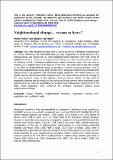Files in this item
Neighbourhood change... reason to leave?
Item metadata
| dc.contributor.author | Feijten, Petra Maria | |
| dc.contributor.author | Van Ham, Maarten | |
| dc.date.accessioned | 2016-01-06T15:40:03Z | |
| dc.date.available | 2016-01-06T15:40:03Z | |
| dc.date.issued | 2009-09 | |
| dc.identifier | 2086882 | |
| dc.identifier | 0775ba60-8943-45b5-8d4d-dddfb3336606 | |
| dc.identifier | 000269029900005 | |
| dc.identifier | 70349192766 | |
| dc.identifier.citation | Feijten , P M & Van Ham , M 2009 , ' Neighbourhood change... reason to leave? ' , Urban Studies , vol. 46 , no. 10 , pp. 2103-2122 . https://doi.org/10.1177/0042098009339430 | en |
| dc.identifier.issn | 0042-0980 | |
| dc.identifier.other | ORCID: /0000-0002-2106-0702/work/64697502 | |
| dc.identifier.uri | https://hdl.handle.net/10023/7979 | |
| dc.description.abstract | Little attention has been paid to date to the role of a changing neighbourhood as a factor influencing the residential choice process. Processes of neighbourhood change are often beyond residents' sphere of influence and if a changing neighbourhood causes residential stress, the only way to improve one's neighbourhood is to move to a better one. This study aims to get more insight into the effect of neighbourhood change on residential stress by studying residents' wish to leave their neighbourhood. Using data from The Netherlands, we show that there is no effect of a change in the socioeconomic status of the neighbourhood on moving wishes. A high level of population turnover and an increase in the proportion of non-Western ethnic minorities in the neighbourhood increase the probability that residents want to leave their neighbourhood. The latter effect disappears when controlled for residents' subjective opinion about neighbourhood change. | |
| dc.format.extent | 20 | |
| dc.format.extent | 395865 | |
| dc.language.iso | eng | |
| dc.relation.ispartof | Urban Studies | en |
| dc.subject | Residential-mobility | en |
| dc.subject | Segregation | en |
| dc.subject | Context | en |
| dc.subject | Move | en |
| dc.subject | Satisfaction | en |
| dc.subject | Migration | en |
| dc.subject | Preferences | en |
| dc.subject | Integration | en |
| dc.subject | Adjustment | en |
| dc.subject | Multilevel | en |
| dc.subject | H Social Sciences (General) | en |
| dc.subject.lcc | H1 | en |
| dc.title | Neighbourhood change... reason to leave? | en |
| dc.type | Journal article | en |
| dc.contributor.institution | University of St Andrews. School of Geography and Geosciences | en |
| dc.contributor.institution | University of St Andrews. Geography & Sustainable Development | en |
| dc.identifier.doi | 10.1177/0042098009339430 | |
| dc.description.status | Peer reviewed | en |
This item appears in the following Collection(s)
Items in the St Andrews Research Repository are protected by copyright, with all rights reserved, unless otherwise indicated.

